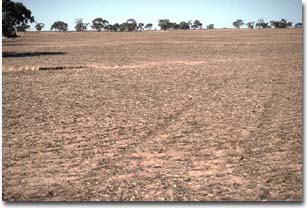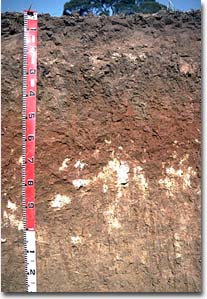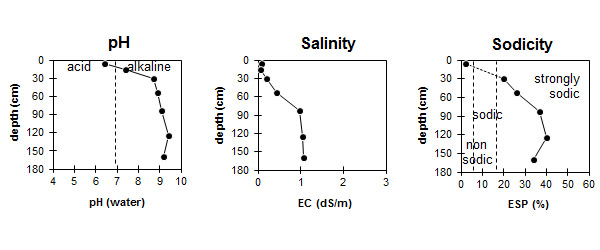Site LS5
Location: Diapur Ridge
Australian Soil Classification: Calcic, Mesonatric, Brown SODOSOL
Northcote Factual Key: Db 1.33
Great Soil Group: solonetz
General Landscape Description: Flat minor ledge on NNW/SSE trending ridge.
 LS5 Landscape |
Soil Profile Morphology:
Surface Soil
| A1 | 0-10 cm | Dark brown (10YR3/3); fine sandy clay loam; weakly structured but fractures into platy fragments (caused by cultivation); firm consistence dry; pH 6.4: |  LS5 Profile |
| A2 | 10-20 cm | Dark brown (10YR3/3); sporadically bleached sandy loam; massive structure; very strong consistence dry; pH 7.4; sharp and wavy change to: | |
| Subsoil | |||
| B21 | 20-40 cm | Dark brown (10YR4/3); medium clay; moderate prismatic, parting to strong blocky structure; very strong consistence dry; pH 8.7: | |
| B22 | 40-65 cm | Brown (10YR5/3); medium heavy clay; strong prismatic, parting to strong blocky structure; very strong consistence dry; pH 8.9: | |
| B23 | 65-100 cm | Yellowish red (5YR4/6); heavy clay; strong prismatic, parting to strong blocky structure; contains few (5 - 10%) soft carbonate segregations as well as very few ironstone nodules; pH 9.1. | |
Key Profile Features:
- Texture contrast between surface (A) horizons and subsoil (B21) horizons.
- Hardsetting surface soil.
Soil Profile Characteristics:
| - | pH | Salinity | ||
Surface (A1 horizon) | Slightly acid | Very Low | Non-Sodic | Slaking, No Dispersion 1 |
Subsoil (B21 horizon) | Strongly alkaline | Very Low | Strongly Sodic | Slight |
Deeper Subsoil (at 1 metre) | Very Strongly Alkaline | High | Strongly Sodic | Complete |

| The surface soil is slightly acid. The subsoil is strongly alkaline becoming very strongly alkaline with depth. | The salinity rating is very low in the surface and upper subsoil becoming high with depth. | The surface is non-sodic. The subsoil is strongly sodic. |
Management Considerations:
Surface (A) Horizons
- When dry the surface soil will set hard and become difficult to work.
- The surface soil may disperse after mechanical shearing during cultivation or by trampling of stock when in a moist to wet condition (as indicated by moderate dispersion after remoulding of aggregates). This would result in a surface soil structure deterioration; restricting seedling emergence and water infiltration. Raindrop action on bare soil can also have a deleterious effect on soil structure, so maintaining surface cover is important.
- Maintaining soil organic matter will assist in the stabilisation of surface soil aggregates against slaking. Practices such as residue retention, minimum tillage and including pasture rotations should be utilised if cropping occurs.
- The surface soil has a moderate inherent fertility (based on the sum of the basic exchangeable cations). Improving organic matter levels will assist in enhancing surface soil fertility and water holding capacity.
- The strongly sodic subsoil is likely to restrict water and root movement down the profile. The sporadic bleach above the subsoil indicates that water movement is being restricted and that periodic waterlogging occurs. Some researchers have advocated deep ripping with gypsum application as an ameliorative technique for sodic subsoils. A test strip could be used to assess likely benefits.
- A medium to high level of soluble salts occur from a depth of 65 cm down the profile. This is likely to restrict the growth of salt sensitive species.
- The subsoil is very strongly alkaline which indicates that nutrients such as iron, manganese, copper and zinc may be poorly available to plants. Plant tissue analysis can be used to determine deficiencies.


